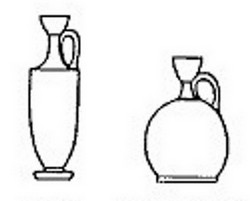
Lekythos

The lekythos is a flask for toilet oils, perfume or condiments having a cylindrical body, a narrow neck with a deep mouth and one handle. The handle reaches from the shoulder to just below the neck
The Greek word lekythos was undoubtedly used for the various forms considered here, although it does appear that it was used for oil-vessels in general. In the early 6th century, the lekythos has an oval-shaped body, - a continuous curve from the neck to the base-, but as with the hydria and neck-amphora, a shouldered-type is developed around the middle of the century troughout the fifth. Another type is the squat lekythos, with a squat body, broad at the base.
The form with a tapering body, continues to be decorated by black-figure painters. But it is the cylindrical type, first preserved from the last third of the sixth-century, that will be predominant in the fifth century, and it is this form that is decorated with polychrome figures on white-ground. Fragmentary examples (and X-ray photography) reveal that some had a smaller inner chamber, to limit the volume of oil that could be held.
Although most Athenian vases were made for domestic use, the lekythoi performed a role in religious ceremony as well, for they are often used as an offering to the dead. The earliest Athenian black-figure lekythoi - by the Gorgon Painter and his followers - appeared in the sixth century B.C. and may be derived from Corinthian shapes. Two types of this early shape may be distinguished: the round lekythos, perhaps derived from the aryballos, and the elongated oval lekythos, perhaps derived from the Corinthian alabastron. Various sub-types were developed, without lasting results, but by about 560 B.C. the variety with the offset shoulder had been invented in an Attic workshop. In succeeding years, these shoulder lekythoi acquired straighter walls, a stronger (almost cup-like) lip, and an inverted echinus foot. By the end of the sixth century B.C. the canonical proportions had been reached. A lekythos by the Diosphos Painter has the word "hirinon" painted on its rim, indicating its use to contain iris-scented oil. It is the Beldam Painter's larger lekythoi which are first to be given false interior compartments, so that the entire vessel need not be filled with oil.